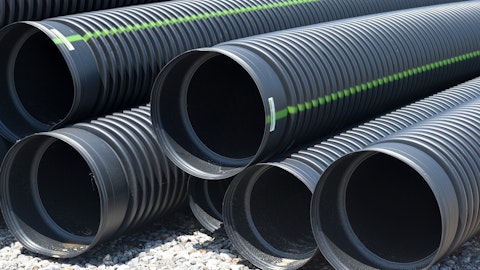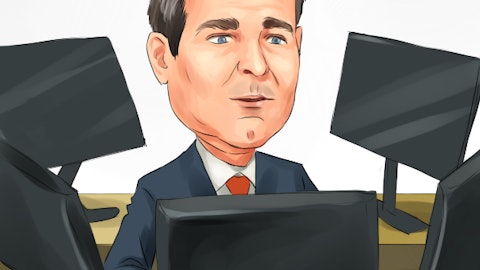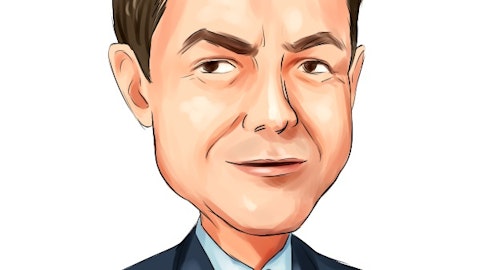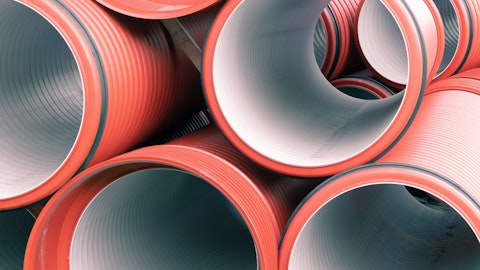Advanced Drainage Systems, Inc. (NYSE:WMS) Q3 2023 Earnings Call Transcript February 2, 2023
Operator: Good morning, ladies and gentlemen, and welcome to the Advanced Drainage Systems Third Quarter of Fiscal Year 2023 Results Conference Call. My name is Bailey, and I’ll be your operator for today’s call. At this time, all participants are in listen-only mode. Later, we will conduct a question-and-answer session. I would now like to turn the presentation over to your host for today’s call, Mr. Mike Higgins, Vice President of Corporate Strategy and Investor Relations. Sir, you may begin.
Mike Higgins: Good morning. Thank you for joining us today. With me today, I have Scott Barbour, our President and CEO; and Scott Cottrill, our CFO. I would also like to remind you that we will discuss forward-looking statements. Actual results may differ materially from those forward-looking statements. because of various factors, including those discussed in our press release and the risk factors identified in our Form 10-K filed with the SEC. While we may update forward-looking statements in the future, we disclaim any obligation to do so. You should not place undue reliance on these forward-looking statements, all of which speak only as of today. Lastly, the press release we issued earlier this morning is posted on the Investor Relations section of our website.
A copy of the release has also been included in an 8-K submitted to the SEC. We will make a replay of this conference call available via webcast on the company website. With that, I’ll turn the call over to Scott Barbour.
Scott Barbour: Thank you, Mike, and I appreciate you all joining us on today’s call. As you saw from our press release issued earlier this morning, the demand environment we are facing today is challenging. We’re seeing domestic construction demand slow, due to rising interest rates and inflation, which in turn is causing uncertainty in the market and slowing the release of projects for shipment and order rates. Before I provide more details on the current environment, I want to talk about the brand promise and value proposition, which have never been more relevant. As you have heard me say many times before, our reason is water. We protect and manage water, the world’s most precious resource, safeguarding our environment and communities.
This business is driven by water and sustainability as a pure-play water company, the need for ADS and Infiltrator products is as important today as it was a year ago. We have a runway for long-term growth in both the storm water and on-site septic wastewater markets, due to the value proposition and from converting projects from traditional materials to environmentally friendly solutions. We also use a high volume of recycling materials, which allow us to better manage our material costs and we are the largest consumer of recycled plastics in North America, giving us additional scale to manage cost and financial performance. We are effectively executing our material conversion strategy. ADS and Infiltrator provides superior products and solutions, which set us apart from the competition from capture to conveyance, storage and treatment, ADS’ comprehensive suite of products is designed to meet the needs of customers for the entire life cycle of a raindrop.
ADS and Infiltrator products install more quickly than traditional materials, saving the contractor labor and time, lighter weight materials are safer on the job site than they have traditional materials, which are much heavier and require additional machinery to unload and install. As part of the material conversion strategy and broader value proposition, we have a vast sales and engineering team in the field working with contractors and civil engineers every day to ensure our products are specified on project plans. ADS products go-to-market through Waterworks distribution partners that extend our sales coverage, thereby ensuring we have great visibility into local construction activity. The value proposition is so much more than simply our superior products and coverage.
From a service standpoint, we have internal engineering services and design tools to assist civil engineers in their site design for underground construction. Through ADS’ company-owned fleet, we deliver directly to the job site and in fewer truckloads than traditional materials. That’s a big advantage for our distribution partners as we enable an asset-light model for ADS products. It is also an advantage on the job site especially in areas of high security like airports or in traffic sensitive areas like highways, fewer deliveries means less job site disruption and better logistics costs. Last, effective capital deployment remains a key pillar of our strategy. Because of the long-term opportunity for growth, we will continue investing in growth regions and products, as well as productivity initiatives including automation and safety.
We continue to execute our M&A strategy, including tuck-in acquisitions such as Jet Polymer and Coltec, which support our recycling and Allied product strategies. Lastly, we remain committed to shareholder returns as Scott will discuss in more detail. Let me now shift gears to the challenging demand environment we are facing. Through October and November, demand continued largely at the pace we expected after the last time we spoke to you. In December, nonresidential and residential demand slowed significantly. In addition to the slowdown in the Northeast and the Northwest that we talked about last quarter, we began to see weakness emerge in other geographies like the Midwest and the West more broadly. From a macro perspective, we look at the same data issue.
For example, the Architectural Billing Index has been showing signs of declining for the past few months. Similar indicators are negative and expected to remain weak for most of calendar 2023. Now let’s transition to results for the quarter. Consolidated net sales declined 8%, the ADS business was down 3%, primarily due to weakness in the non-residential market and shipments to retail partners. The 30% decline in Infiltrator sales was a result of reduced housing starts and completions and the last of the inventory destocking, which completed in the fiscal third quarter as we previously communicated. As we look at the significant change in market dynamics that impact construction activity, since the beginning of the fiscal year, interest rates nearly doubling and significant inflation, there is no doubt this is creating uncertainty in our construction end markets.

Photo by Timothy L Brock on Unsplash
This combination has slowed down demand for the ADS and Infiltrator products, and we expect this challenging demand environment to persist through the majority of calendar year 2023. This slower market environment creates two key areas of focus: one, lower demand volume; and two, higher absorption costs. Lower demand volume will partially — will be partially offset by material conversion and growth strategies, including the priority focused states and new products. We will address the higher absorption costs through headcount reductions, plant closures and manufacturing improvements. We will continue to hold the favorable pricing we have established for the products and services we provide to our customers. Importantly, we remain committed to the 28% to 29% adjusted EBITDA margin range we communicated at Investor Day in March of last year.
We have a number of levers we are working to execute margin performance during this period of slower end market demand. We are optimizing the network, closing three facilities by the end of March. From our peak, we are taking out approximately 15% of the manufacturing and transportation workforce through reduction in attrition. We have also eliminated temporary labor and minimized our overtime. In transportation, we are removing many of our high-cost lanes and reducing the use of third-party logistics services, both of which we use quite frequently during periods of higher demand. We are doubling down on improving productivity through our commitment to continuous improvement initiatives. This includes investment in automation, improvements in downtime and better training and tools for our employees to drive higher overall productivity.
Lastly, we are rightsizing inventory to reflect current demand levels, which is contemplated in the guidance issued today. While we look at all cost control measures, we will also continue investing in our business to ensure we exit the current environment in a stronger competitive position. This includes continuing to invest in high-growth areas in the priority states. The recent Texas Department of Transportation, approval for the use of thorough plastic corrugated pipe is evidence of the additional market participation opportunity and the strength of ADS’ market leadership. For your reference, Texas is the largest storm water market in the U.S. We will also continue to lean in on markets that we know will grow in calendar 2023, like the infrastructure market, due to the Infrastructure Investment and Jobs Act, industrial manufacturing, such as onshoring EVs and batteries, as well as the agriculture market, which remains strong.
In summary, the strength of our model remains intact and the brand promise and value proposition have never been more relevant. We continue to generate significant cash flow in our excellent financial health. With that, let me turn it over to Scott Cottrill.
Scott Cottrill: Thanks, Scott. As Scott mentioned, our sales were down 8% in the quarter, due to weakness in both our domestic residential and non-residential end markets. The decline in single-family housing starts — that started in May and sequentially worsened throughout calendar 22, continues to impact demand for our Infiltrator products and is beginning to impact the ADS residential business as well. Looking into ADS’ residential business, as we got into December, we experienced slowing demand for the first time in fiscal 2023. As homebuilders pause on lot development due to the decline in housing starts and the current uncertainty in the market. While we are a cyclical company and as such, are impacted by the lower end market demand, it is important to highlight secular growth trends around the Infrastructure Investment and Jobs Act money that would be coming into play during calendar 23, onshoring and nearshoring trends, as well as the recent Texas Department of Transportation approval for the use of thermoplastic pipe.
As we have consistently demonstrated, we will continue to outperform our end markets, due to our material conversion strategy, innovative solutions package, our large national distributor relationships and partnerships and our national workforce. It is also important that we take appropriate cost containment actions that reflect the lower demand environment we are experiencing. As Scott noted, these actions include: first, optimizing our footprint with the announced closure of three facilities; second, reducing our head count by approximately 15%, elimination of temp workers, as well as significant reductions in overtime work; third, manufacturing efficiency and productivity initiatives; and fourth, the elimination of high-cost transportation lanes.
The majority of the savings resulting from these actions that I just noted will be realized in fiscal year ’24. Regarding our profitability in the quarter, I wanted to highlight that despite the lower demand, we were able to expand our adjusted EBITDA margins by 130 basis points year-over-year. We experienced favorable price cost in the quarter, driven by continued favorable pricing year-over-year, as well as favorable material input costs. Our ability to maintain favorable pricing is something we earn every day through our value proposition to our customers, as well as investments in the business that we continue to make. Moving to slide six. We generated $534 million of free cash flow year-to-date compared to $93 million in the prior year.
We had more than $1 billion of liquidity at the end of the quarter, of which over $400 million was in cash. Our trailing 12-month adjusted EBITDA to debt ratio is at 1 times at the end of December. From a capital allocation perspective, we remain committed to investing in the business, strategic M&A and returning excess cash to our shareholders. Our target leverage ratio is currently 1.5 times, given the current market uncertainty we are experiencing. Examples of investing in the business include debottlenecking our recycling operations, continued automation of our pipe manufacturing plants, accelerating our material science and engineering capabilities through our new world-class engineering and technology center that we are currently constructing in Hilliard, Ohio, as well as investing in Florida and the Southeast, where we continue to see strong growth.
As I noted, we are targeting a leverage ratio of 1.5 times, returning excess cash to shareholders through our share buyback program and recurring dividends. Through December 2022, we repurchased 3.8 million shares of our common stock for $375 million. This leaves $625 million left under the current share repurchase authorization as of the end of December. We plan to continue the share repurchase program here in the fourth quarter and based on our current leverage — look to accelerate the pace of such, here in the near-term. Moving to our expectations as we close out fiscal 2023. We have updated our guidance based on order activity, backlog and current market trends. We currently expect our fiscal year 2023 revenue to be between $2.975 billion and $3.050 billion, representing growth of 7% to 10% from fiscal 2022.
Based on that revenue range, we expect adjusted EBITDA to be between $850 million and $890 million, representing growth of 26% to 32%, compared to last year and margin expansion of 420 basis points to 480 basis points. All in, the strength of our model remains intact, and we remain confident in our ability to outperform our end markets by increasing market share while also remaining committed to the adjusted EBITDA margin target of 28% to 29% we noted at our Investor Day back in March. The investments we are making now will ensure we improve upon our strong competitive position and prepare us to come out of the current downturn and an even stronger position. The most that make ADS the market leader we are today have not changed. Our total installed cost benefit and solutions package continue to make us the premier manufacturer for our large national distribution partners.
Our large sales force and manufacturing footprint encompass the entire United States, which are further supported by our distribution relationships and the company-owned fleet. In addition, we can control our costs better than our competitors due to our use of recycled materials and our recycling footprint. With that, I’ll open the call for questions. Operator, please go ahead.
See also 12 Top Performing Energy Stocks in January and 15 Biggest Neuroscience Companies in the World .
Q&A Session
Follow Wms Industries Inc (NYSE:WMS)
Follow Wms Industries Inc (NYSE:WMS)
Operator: Thank you. The first question today comes from the line of Michael B. Halloran from Baird. Please go ahead, your line is now open.
Michael Halloran: Thanks. Good morning, everyone.
Scott Barbour: Good morning.
Michael Halloran: So a couple of questions here. First, can you just give a little more context to the downdraft that we saw in December here and put it in context to a couple of things. One, what the backlog looks like? I certainly saw the comments on the order book starting to normalize towards call it, normal lead times. But what kind of visibility does the backlog give you at this point? Are you seeing any cancellations on that side. And then secondarily, have you seen any shift in that dynamic December versus January or shift in tone in the customer conversations? Can you just maybe help more on the non-res side of the business than the other pieces because I think that’s where the more pronounced change was relative to what we would have expected coming out of the last quarter?
Scott Barbour: Okay. Got it. This is Scott B. Good morning, Michael. So as we said, October, November cruising along. And in December, really midway through, just short and midway through the month, things just stop shipping. There was — I mean this was across the board geographically and in most all market segments. I think some of that was people just not wanting to bring in inventory or put material on job sites before the end of the year. Certainly, the retailers were slowing down for that reason. They’re kind of coming off tougher comps, but that do-it-yourselfer thing weakened. But the non0-residential piece really stuff quit shipping to job sites and distributors, those last really 15-days. There’s some weather in there in some key areas of the country, too, that didn’t help, but it wasn’t all driven by that.
Sentiment today versus back in December, well, things started up. January kind of came in like we thought it was going to come in. January is always a tough month. You got to start the year, you got to get up on pace. So it was about like we expected at both companies. I wouldn’t say sentiment has gotten a lot better, though. It didn’t got worse, but I would — we just don’t hear people or see order rates improving or any big green shoots. There are still projects coming along. We’re so kind of good quoting activity, all that kind of stuff. But I would not say that everyone feels in this industry that kind of the uptick is coming back. That said, as we talked about with you guys a lot, that bottom right corner of the map, the Florida, the Southeast on over to Texas up into the Carolinas, remains still strong year-over-year and going quite well.
We’re very encouraged by the activity we’ve even seen so far from a kind of project pursuit and quoting in Texas. And that really only had that approval since November. So we — that was when the gun kind of officially sounded. Mike, Scott, do you add anything?
Michael Higgins: Yes, Mike Higgins. I think your question, too, about the backlog, I would characterize the backlog at both companies is coming off to kind of pre-pandemic levels, some more normalized.
Scott Barbour: Yes, good point.
Michael Halloran: No, that’s helpful. The margin side, relative to how the revenue shook out, margins were quite resilient. Obviously, the commentary about the sticking to that 28%, 29% kind of range is encouraging. Just a little context on how pricing is tracking? Are you seeing sequential changes in pricing? And then maybe put that in context of how the price cost side of things have tracked because it seems like that’s held in very well.




